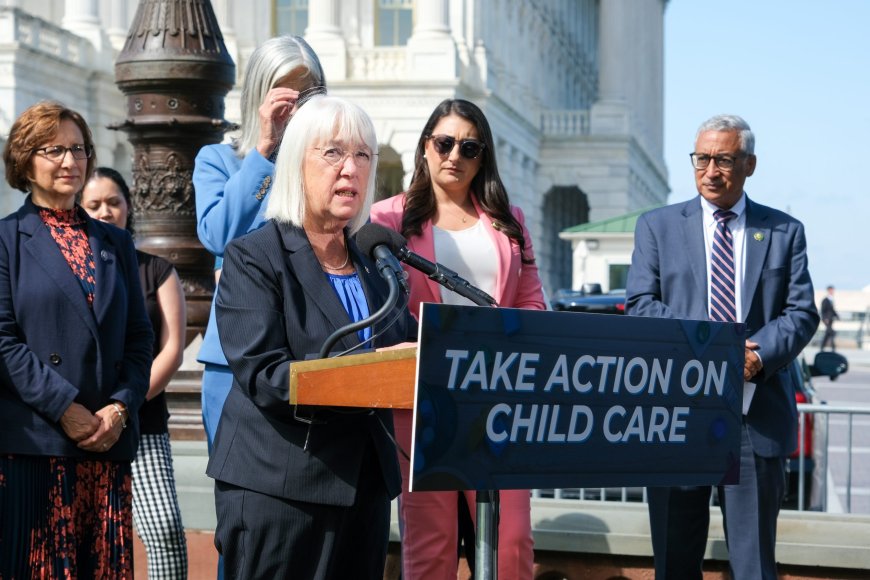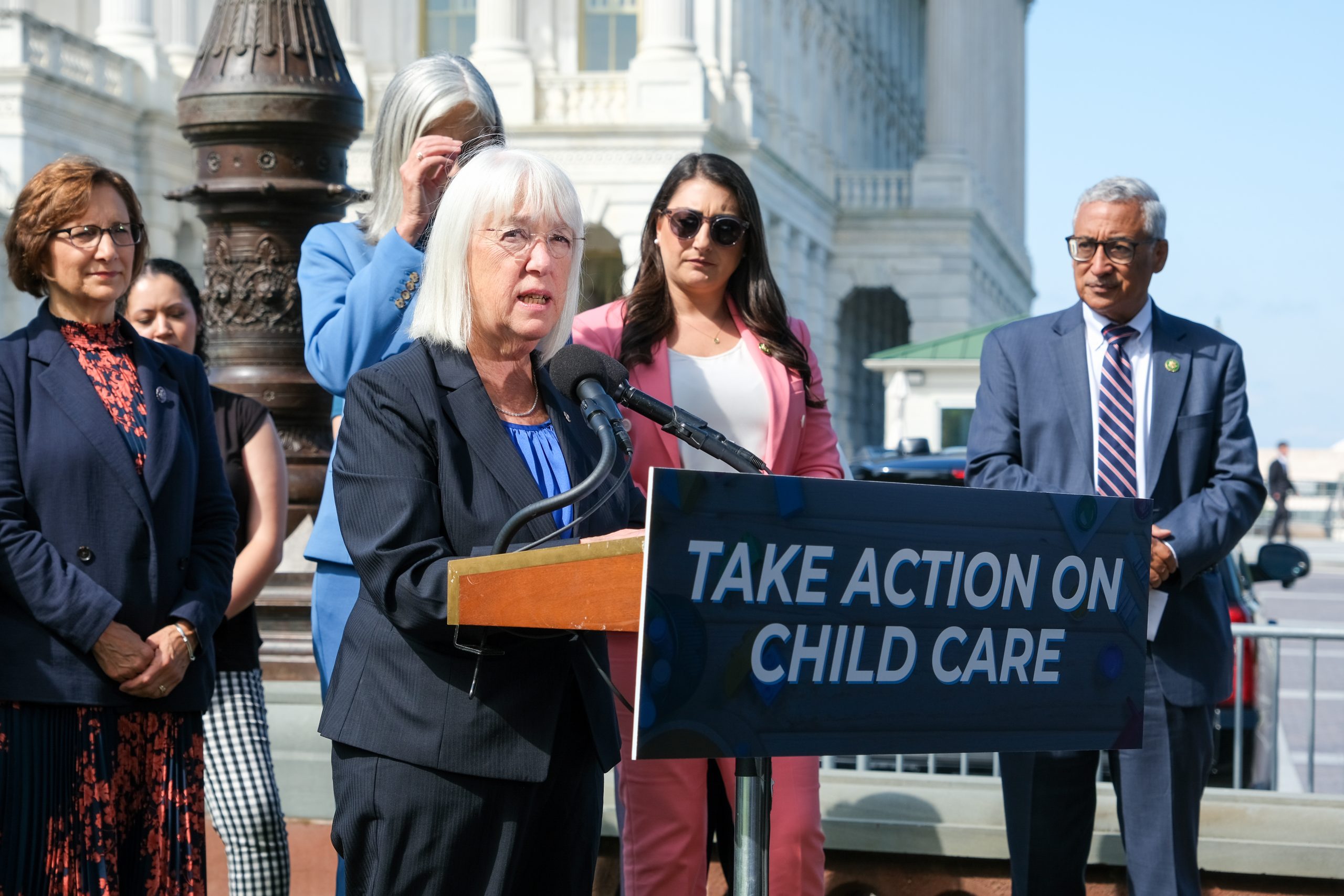Murray, Sanders, Clark, Colleagues Introduce Bill to Extend Vital Child Care Funding and Save Millions of Families’ Child Care Spots as Funding Cliff Looms – Senator Patty Murray
Murray, Sanders, Clark, Colleagues Introduce Bill to Extend Vital ... Senator Patty Murray


Democrats Introduce Child Care Stabilization Act to Extend Funding and Prevent Crisis
Introduction
Democrats saved the child care sector from collapse during the pandemic with vital stabilization funding—which helped 220,000 providers stay afloat and serve as many as 10 million kids—but with funding set to expire September 30, the child care sector may once again be pushed to the brink, with potentially dire consequences for families and our economy
The Child Care Stabilization Act would extend vital stabilization funding to prevent a potential crisis for families and our economy by ensuring child care providers can continue serving families across the country
Introduction of the Child Care Stabilization Act
WATCH: Murray, Sanders, Clark, colleagues rally with providers and parents in push to extend funding
Washington, D.C. – Today, Senator Patty Murray (D-WA), Chair of the Senate Appropriations Committee, Senator Bernie Sanders (I-VT), Chair of the Senate Health, Education, Labor, and Pensions (HELP) Committee, House Democratic Whip Katherine Clark (D-MA-05), Representative Rosa DeLauro (D-CT-03), Ranking Member of the House Appropriations Committee, Representative Bobby Scott (D-VA-03), Ranking Member of the House Committee on Education and the Workforce, and Representatives Suzanne Bonamici (D-OR-01), Mikie Sherrill (D-NJ-11), Sara Jacobs (D-CA-51), Jimmy Gomez (D-CA-34), and Jamaal Bowman, Ed.D. (D-NY-16) introduced the Child Care Stabilization Act to extend vital federal child care stabilization funding—which is set to expire at the end of this month—and ensure that child care providers can keep their doors open and continue serving children and families in every part of the country.
The Importance of Child Care Stabilization Funding
When the pandemic pushed the already-fragile child care sector to the brink of collapse, Democrats in Congress responded by delivering historic federal investments to save the sector from collapse and prevent families from losing their child care spots—including $24 billion in child care stabilization funding. The funding has made an enormous difference for families across the country—keeping 220,000 child care providers afloat over the last few years and saving child care slots for up to 10 million kids nationwide—but it is set to run out on September 30, 2023, threatening to once again push the sector to the brink, with dire consequences for families and our nation’s economy.
The Child Care Stabilization Act: Preventing a Crisis
The Child Care Stabilization Act would prevent a potential crisis when funding expires at the end of the month by providing $16 billion in mandatory funding each year for the next five years to continue the successful Child Care Stabilization Grant program. This investment would ensure child care providers continue to receive a stable and reliable source of funding to help them deliver high-quality and affordable child care for working families across the country.
Statements from Senators and Representatives
“There was a child care crisis even before the pandemic—and failing to extend these critical investments from the American Rescue Plan will push child care even further out of reach for millions of families and jeopardize our strong economic recovery,” said Senator Murray. “This is an urgent economic priority at every level: child care is what allows parents to go to work, businesses to hire workers, and it’s an investment in our kids’ futures. The child care industry holds up every sector of our economy—and Congress must act now.”
“We have a child care crisis in America that we have got to address. If Congress does not act soon, over 3 million kids are in danger of losing their child care slots, over 230,000 child care workers could lose their jobs, and child care facilities all over our country could be forced to close their doors,” said Senator Sanders. “That would be unacceptable. In the richest country in the history of the world, we can and we must make sure that every kid in America has access to high quality, affordable child care. If we can afford to spend over $1 trillion on tax breaks for the top one percent and large corporations making record-breaking profits, we can afford to provide working class families with the child care they desperately need. This legislation is needed now more than ever.”
“America’s families are facing a child care crisis – and is imperative that we step up to stop it. Ensuring access to affordable and accessible child care is essential; as our economy strengthens under President Biden, we need to continue to ensure all Americans – especially women – can access the workforce, a critical aspect of which is reliable access to dependable child care,” said Leader Schumer. “The Child Care Stabilization Act will avert the nightmare scenario too many American families stay up at night worrying about by providing mandatory funding to support high-quality childcare. As Majority Leader, I will always fight for America’s children and families.”
“Too many families are struggling to find reliable, affordable child care or preschool and feel like they’re on their own. The child care crisis predated the pandemic, but the funding provided in the American Rescue Plan kept centers afloat during their darkest hours,” said Senator Casey. “Without new investments, parents will have a harder time finding care, which in turn impacts businesses and local economies. It’s time for the government to step up and set up our kids and families for success by making a meaningful investment in child care and the child care workforce.”
“The lack of affordable child care in America is holding our families, workers, and economy back,” said Senator Kaine. “Parents are locked out of the workforce because they can’t find care for their kids. Workers who are passionate about child care are being squeezed out of their field because they can’t pay their bills. If we let critical child care stabilization funding expire, things are only going to get worse. Millions of families who will otherwise lose their child care are depending on Congress passing this legislation to extend these urgently-needed funds.”
“Across the country, affordable child care is out of reach for too many families, stopping parents from getting back
SDGs, Targets, and Indicators
SDGs Addressed or Connected to the Issues Highlighted in the Article:
- SDG 1: No Poverty
- SDG 4: Quality Education
- SDG 5: Gender Equality
- SDG 8: Decent Work and Economic Growth
- SDG 10: Reduced Inequalities
- SDG 16: Peace, Justice, and Strong Institutions
Specific Targets Based on the Article’s Content:
- Target 1.3: Implement nationally appropriate social protection systems and measures for all, including floors, and by 2030 achieve substantial coverage of the poor and the vulnerable.
- Target 4.2: By 2030, ensure that all girls and boys have access to quality early childhood development, care, and pre-primary education so that they are ready for primary education.
- Target 5.4: Recognize and value unpaid care and domestic work through the provision of public services, infrastructure, and social protection policies and the promotion of shared responsibility within the household and the family as nationally appropriate.
- Target 8.5: By 2030, achieve full and productive employment and decent work for all women and men, including for young people and persons with disabilities, and equal pay for work of equal value.
- Target 10.2: By 2030, empower and promote the social, economic, and political inclusion of all, irrespective of age, sex, disability, race, ethnicity, origin, religion, or economic or other status.
- Target 16.6: Develop effective, accountable, and transparent institutions at all levels.
Indicators Mentioned or Implied in the Article:
- Indicator 1.3.1: Proportion of population covered by social protection floors/systems, by sex, distinguishing children, unemployed persons, older persons, persons with disabilities, pregnant women, newborns, work-injury victims, and the poor and vulnerable.
- Indicator 4.2.1: Proportion of children under 5 years of age who are developmentally on track in health, learning, and psychosocial well-being, by sex.
- Indicator 5.4.1: Proportion of time spent on unpaid domestic and care work, by sex, age, and location.
- Indicator 8.5.1: Average hourly earnings of female and male employees, by occupation, age group, and persons with disabilities.
- Indicator 10.2.1: Number of countries that have implemented well-managed migration policies.
- Indicator 16.6.1: Primary government expenditures as a proportion of original approved budget, by sector (or by budget codes or similar), disaggregated by sex, age, and persons with disabilities.
Table: SDGs, Targets, and Indicators
| SDGs | Targets | Indicators |
|---|---|---|
| SDG 1: No Poverty | Target 1.3: Implement nationally appropriate social protection systems and measures for all, including floors, and by 2030 achieve substantial coverage of the poor and the vulnerable. | Indicator 1.3.1: Proportion of population covered by social protection floors/systems, by sex, distinguishing children, unemployed persons, older persons, persons with disabilities, pregnant women, newborns, work-injury victims, and the poor and vulnerable. |
| SDG 4: Quality Education | Target 4.2: By 2030, ensure that all girls and boys have access to quality early childhood development, care, and pre-primary education so that they are ready for primary education. | Indicator 4.2.1: Proportion of children under 5 years of age who are developmentally on track in health, learning, and psychosocial well-being, by sex. |
| SDG 5: Gender Equality | Target 5.4: Recognize and value unpaid care and domestic work through the provision of public services, infrastructure, and social protection policies and the promotion of shared responsibility within the household and the family as nationally appropriate. | Indicator 5.4.1: Proportion of time spent on unpaid domestic and care work, by sex, age, and location. |
| SDG 8: Decent Work and Economic Growth | Target 8.5: By 2030, achieve full and productive employment and decent work for all women and men, including for young people and persons with disabilities, and equal pay for work of equal value. | Indicator 8.5.1: Average hourly earnings of female and male employees, by occupation, age group, and persons with disabilities. |
| SDG 10: Reduced Inequalities | Target 10.2: By 2030, empower and promote the social, economic, and political inclusion of all, irrespective of age, sex, disability, race, ethnicity, origin, religion, or economic or other status. | Indicator 10.2.1: Number of countries that have implemented well-managed migration policies. |
| SDG 16: Peace, Justice, and Strong Institutions | Target 16.6: Develop effective, accountable, and transparent institutions at all levels. | Indicator 16.6.1: Primary government expenditures as a proportion of original approved budget, by sector (or by budget codes or similar), disaggregated by sex, age, and persons with disabilities. |
Behold! This splendid article springs forth from the wellspring of knowledge, shaped by a wondrous proprietary AI technology that delved into a vast ocean of data, illuminating the path towards the Sustainable Development Goals. Remember that all rights are reserved by SDG Investors LLC, empowering us to champion progress together.
Source: murray.senate.gov

Join us, as fellow seekers of change, on a transformative journey at https://sdgtalks.ai/welcome, where you can become a member and actively contribute to shaping a brighter future.







